high beam OLDSMOBILE SILHOUETTE 1997 Owners Manual
[x] Cancel search | Manufacturer: OLDSMOBILE, Model Year: 1997, Model line: SILHOUETTE, Model: OLDSMOBILE SILHOUETTE 1997Pages: 436, PDF Size: 21.87 MB
Page 89 of 436
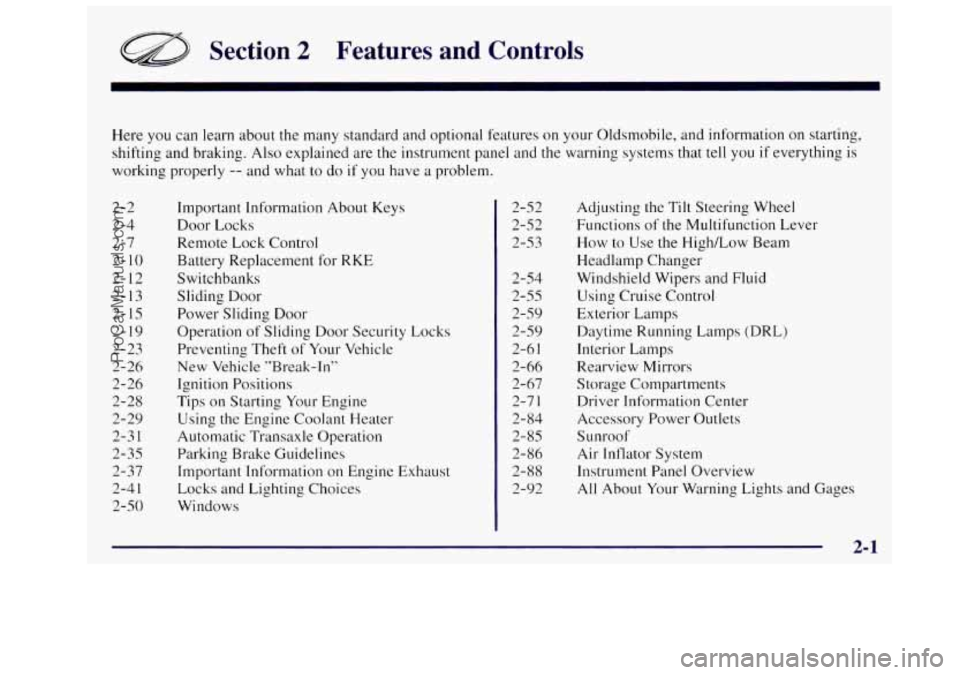
Section 2 Features and Controls
Here you can learn about the many standard and optional features on your Oldsmobile, and information on starting,
shifting and braking. Also explained are the instrument panel and the warning systems that
tell you if everything is
working properly
-- and what to do if you have a problem.
2-2 2-4
2-7
2-
10
2- 12
2-13 2-15
2-19
2-23
2-26 2-26
2-28 2-29
2-3 1
2-35
2-37
2-4
1
2-50 Important Information About Keys
Door Locks
Remote Lock
Control
Battery Replacement for RKE
Switchbanks
Sliding Door
Power Sliding Door
Operation of Sliding Door Security Locks
Preventing Theft
of Your Vehicle
New Vehicle "Break-In"
Ignition Positions
Tips on Starting
Your Engine
Using the Engine Coolant Heater
Automatic Transaxle Operation
Parking Brake Guidelines
Important Information on Engine Exhaust
Locks and Lighting Choices
Windows 2-52
2-52
2-53
2-54
2-55
2-59
2-59
2-6
I
2-66
2- 67
2-7
I
2- 84
2-85
2- 86
2-88
2-92 Adjusting the
Tilt Steering
Wheel
Functions of the Multifunction Lever
How to Use
the High/Low Beam
Headlamp Changer
Windshield Wipers and Fluid
Using Cruise Control
Exterior Lamps
Daytime Running Lamps (DRL)
Interior Lamps
Rearview Mirrors
Storage Compartments
Driver Information Center
Accessory Power Outlets
S u nroo f
Air Inflator System
Instrument Panel Overview
All About Your Warning Lights and Gages
ProCarManuals.com
Page 140 of 436

Tilt Steering Wheel
A tilt steering wheel allows you to adjust the steering
wheel before you drive.
You can also raise it to the
highest level to give your legs more room when you exit
and enter the vehicle.
To tilt the wheel, hold the
steering wheel and pull the
lever. Move the steering
wheel to a comfortable
level, then release the lever
to
lock the wheel in place.
Turn SignaUMultifunction Lever
The lever on the left side of the steering column
includes your:
Turn Signal and Lane Change Indicator,
Headlamp High/Low Beam Changer,
0 Windshield Wiper and Washer Control and
0 Cruise Control (Option).
2-52
,
ProCarManuals.com
Page 141 of 436
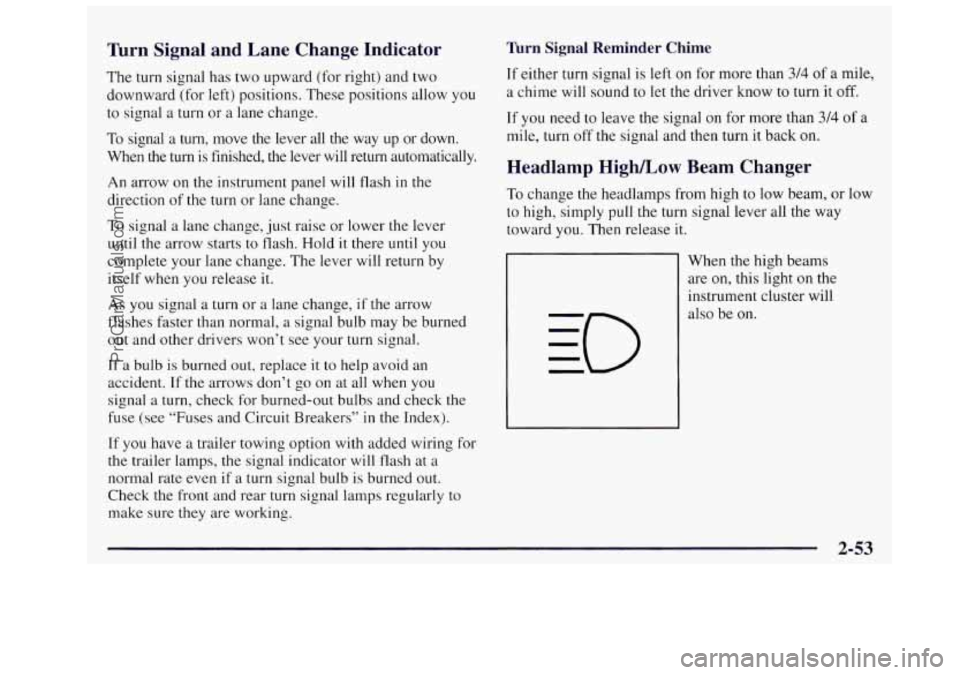
Turn Signal and Lane Change Indicator
The turn signal has two upward (for right) and two
downward (for left) positions. These positions allow you
to signal a turn or
a lane change.
To signal a turn, move the lever all the way up or down.
When the turn is finished, the lever will return automatically.
An arrow on the instrument panel will flash in the
direction of the turn or lane change.
To signal a lane change, just raise or lower the lever
until the arrow starts to flash. Hold it there until you
complete your lane change. The lever will return by
itself when
you release it.
As you signal a turn or a lane change, if the arrow
flashes faster than normal, a signal bulb may be burned
out and other drivers won’t see your turn signal.
If a bulb is burned out, replace it to help avoid an
accident. If the arrows don’t go on at all when you
signal
a turn, check for burned-out bulbs and check the
fuse (see “Fuses and Circuit Breakers”
in the Index).
If you have a trailer towing option with added wiring for
the trailer lamps, the signal indicator will flash at a
normal rate even
if a turn signal bulb is burned out.
Check the front and rear turn signal lamps regularly to
make sure
they are working.
Turn Signal Reminder Chime
If either turn signal is left on for more than 3/4 of a mile,
a chime will sound to let the driver know to turn it off.
If you need to leave the signal on for more than 3/4 of a
mile, turn off the signal and then turn it back on.
Headlamp HigWLow Beam Changer
To change the headlamps from high to low beam, or low
to high, simply pull
the turn signal lever all the way
toward you. Then release it.
When the high beams
are on, this light on the
instrument cluster will
also be on.
2-53
ProCarManuals.com
Page 149 of 436
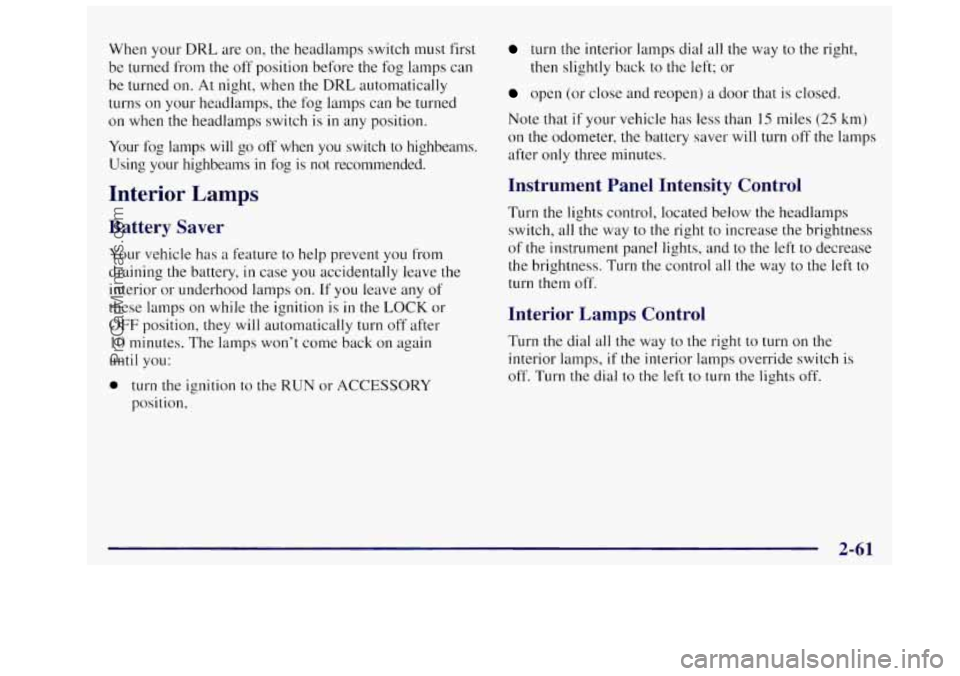
When your DRL are on, the headlamps switch must first
be turned from the off position before
the fog lamps can
be turned on. At night, when the
DRL automatically
turns on your headlamps,
the fog lamps can be turned
on
when the headlamps switch is in any position.
Your fog lamps will go
off when you switch to highbeams.
Using your highbeams
in fog is not recommended.
Interior Lamps
Battery Saver
Your vehicle has a feature to help prevent you from
draining the battery,
in case you accidentally leave the
interior or underhood lamps on.
If you leave any of
these lamps on while the ignition is in the LOCK or
OFF position, they will automatically turn off after
10 minutes. The lamps won’t come back on again
until you:
0 turn the ignition to the RUN or ACCESSORY
position,
turn the interior lamps dial all the way to the right,
then slightly back to
the left; or
open (or close and reopen) a door that is closed.
Note that
if your vehicle has less than 15 miles (25 km)
on the odometer, the battery saver will turn off the lamps
after only three minutes.
Instrument Panel Intensity Control
Turn the lights control, located below the headlamps
switch, all the way to the right to increase the brightness
of the instrument panel lights, and to the left to decrease
the brightness. Turn the control
all the way to the left to
turn them
off.
Interior Lamps Control
Turn the dial all the way to the right to turn on the
interior lamps,
if the interior lamps override switch is
off. Turn the dial to the left to turn the lights off.
2-61
ProCarManuals.com
Page 243 of 436
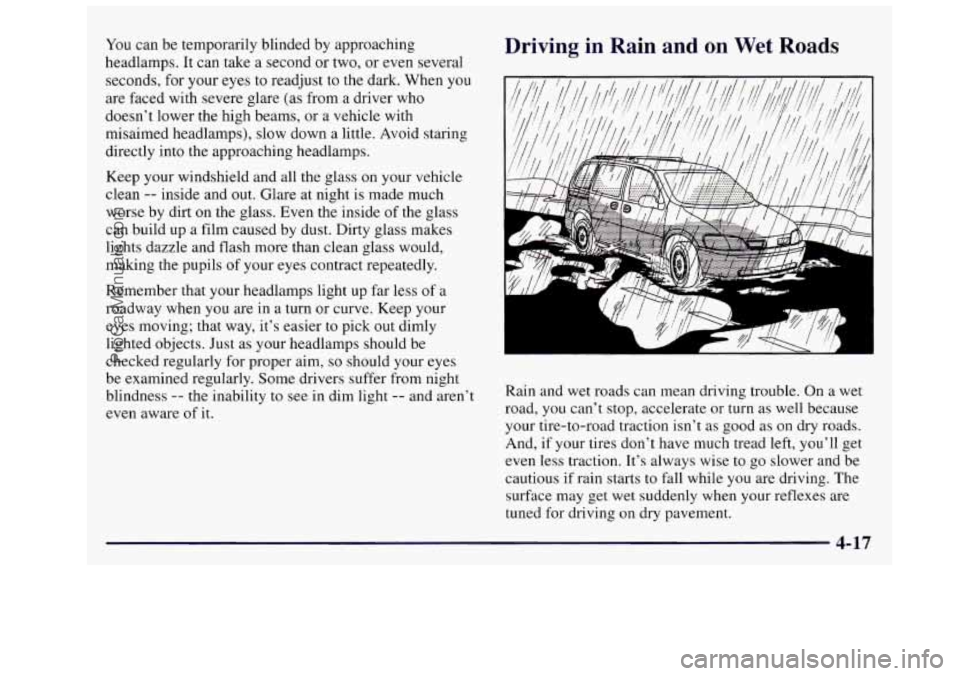
You can be temporarily blinded by approaching
headlamps. It can take a second or two, or even several
seconds, for your eyes to readjust to the dark. When you
are faced with severe glare (as from a driver who
doesn’t lower the high beams, or a vehicle with
misaimed headlamps), slow down a little. Avoid staring
directly into the approaching headlamps.
Keep your windshield and all the glass on your vehicle
clean
-- inside and out. Glare at night is made much
worse by dirt on the glass. Even the inside of the glass
can build up a film caused by dust. Dirty glass makes
lights dazzle and flash more than clean glass would,
making the pupils of your eyes contract repeatedly.
Remember that your headlamps light up far less
of a
roadway when you are in a turn or curve. Keep your
eyes moving; that way, it’s easier to pick out dimly
lighted objects. Just as your headlamps should be
checked regularly for proper aim,
so should your eyes
be examined regularly. Some drivers suffer from night
blindness
-- the inability to see in dim light -- and aren’t
even aware
of it.
Driving in Rain and on Wet Roads
1 V A
Rain and wet roads can mean driving trouble. On a wet
road, you can’t stop, accelerate or turn as well because
your tire-to-road traction isn’t as good as on dry roads.
And, if your tires don’t have much tread left, you’ll get
even less traction. It’s always wise to
go slower and be
cautious if rain starts to fall while
you are driving. The
surface may get wet suddenly when your reflexes are
tuned for driving
on dry pavement.
ProCarManuals.com
Page 245 of 436
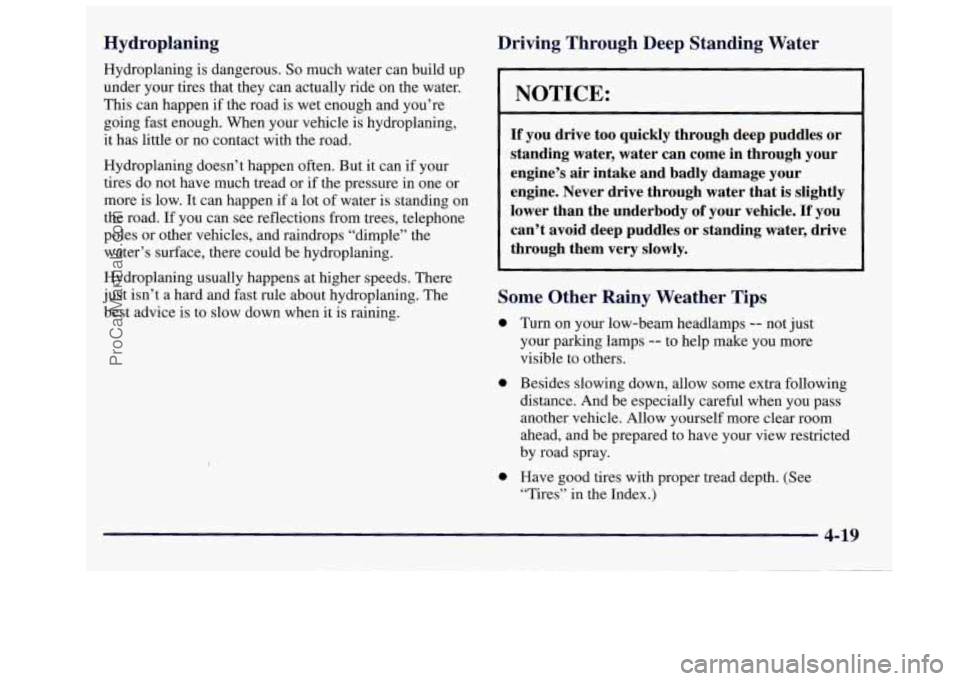
Hydroplaning
Hydroplaning is dangerous. So much water can build up
under your tires that they can actually ride on the water.
This can happen if the road
is wet enough and you’re
going fast enough. When your vehicle is hydroplaning,
it has little or no contact with the road.
Hydroplaning doesn’t happen often. But it can if your
tires do not have much tread or if
the pressure in one or
more is low. It can happen if a lot of water is standing on
the road. If you can see reflections from trees, telephone
poles
or other vehicles, and raindrops “dimple” the
water’s surface, there could be hydroplaning.
Hydroplaning usually happens at higher speeds. There
just isn’t a hard and fast rule about hydroplaning. The
best advice is to slow down when it is raining.
Driving Through Deep Standing Water
I
NOTICE:
If you drive too quickly through deep puddles or
standing water, water can come in through your
engine’s air intake and badly damage your
engine. Never drive through water that is slightly
lower than the underbody of your vehicle. If you
can’t avoid deep puddles or standing water, drive
through them very slowly.
Some Other Rainy Weather Tips
a
a
a
Turn on your low-beam headlamps -- not just
your parking lamps
-- to help make you more
visible to others.
Besides slowing down, allow some extra following
distance. And be especially careful when you pass
another vehicle. Allow yourself more clear room
ahead, and be prepared to have your view restricted
by road spray.
Have good tires with proper tread depth. (See “Tires” in the Index.)
4-19
ProCarManuals.com
Page 425 of 436
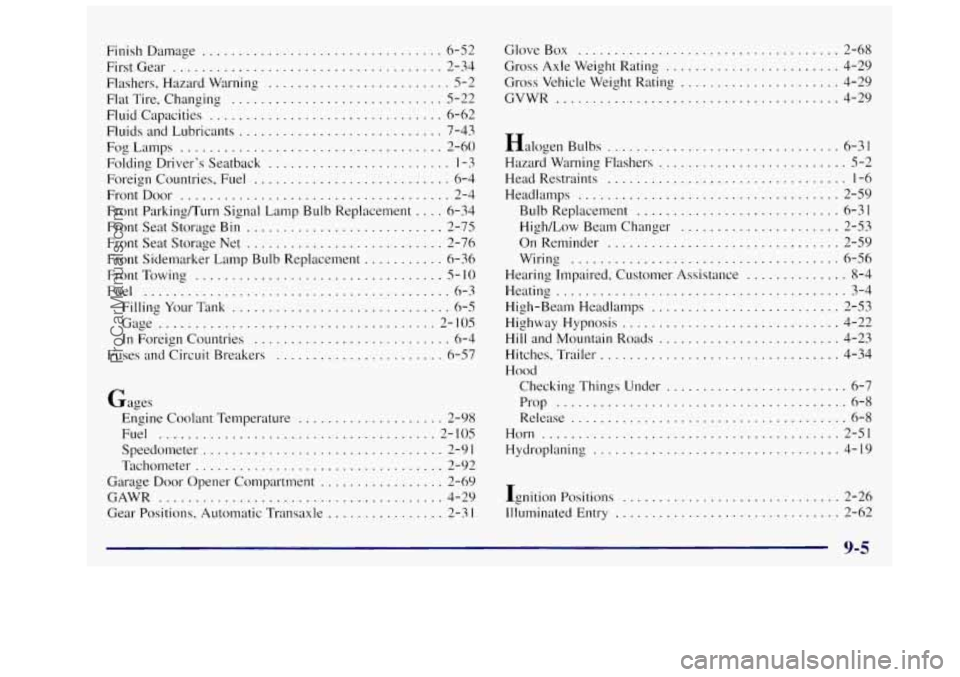
Finish Damage ................................. 6-52
FirstGear
..................................... 2-34
Flashers. Hazard Warning
......................... 5-2
Flat Tire. Changing
............................. 5-22
Fluid Capacities
................................ 6-62
Fluids and Lubricants
............................ 7-43
FogLamps
.................................... 2-60
Folding Driver's Seatback
......................... 1-3
Foreign Countries. Fuel ........................... 6-4
FrontDoor
..................................... 2-4
Front Parking/Turn Signal Lamp Bulb Replacement
.... 6-34
Front Seat Storage Bin
........................... 2-75
Front Seat Storage Net
........................... 2-76
Front Sidemarker Lamp Bulb Replacement
........... 6-36
FrontTowing
.................................. 5-10
Fuel .......................................... 6-3
Filling Your Tank
.............................. 6-5
Gage ...................................... 2-105
In Foreign Countries ........................... 6-4
Fuses and Circuit Breakers ....................... 6-57
Gages Engine Coolant Temperature
.................... 2-98
Fuel
...................................... 2-105
Speedometer ................................. 2-9 1
Tachometer .................................. 2-92
Garage Door Opener Compartment
................. 2-69
Gear Positions. Automatic Transaxle
................ 2-3 I
GAWR ....................................... 4-29 GloveBox
.................................... 2-68
Gross Axle Weight Rating
........................ 4-29
Gross Vehicle Weight Rating
...................... 4-29
GVWR
....................................... 4-29
Halogen Bulbs
................................ 6-31
Hazard Warning Flashers
.......................... 5-2
Head Restraints ................................. 1-6
Headlamps
.................................... 2-59
Bulb Replacement ............................ 6-31
High/Low Beam Changer
...................... 2-53
OnReminder
................................ 2-59
Wiring
..................................... 6-56
Hearing Impaired, Customer Assistance
.............. 8-4
Heating
........................................ 3-4
High-Beam Headlamps
.......................... 2-53
Highway Hypnosis
.............................. 4-22
Hill and Mountain Roads ......................... 4-23
Hitches, Trailer
................................. 4-34
Hood
Checking Things Under ......................... 6-7
Prop
........................................ 6-8
Release ...................................... 6-8
Horn ......................................... 2-51
Hydroplaning
.................................. 4-19
Ignition Positions
.............................. 2-26
Illuminated Entry
............................... 2-62
9-5
__ . .- ~
ProCarManuals.com